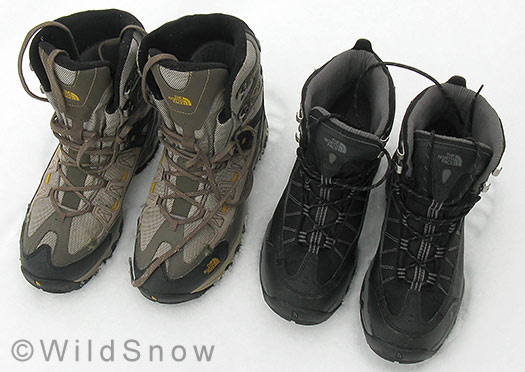Good shoe options, on sale now at backcountry.com.
One of my gear goals this winter was to come up with some “knock around” winter boots that were light on my feet, warm, and kept me dryer than my usual athletic shoes. Ideally, they’d even work as snowmobile boots. Four Shadows boots from The North Face have fit the bill, and made mountain living much more comfortable.

TNF Four Shadows GTX on left, Two Shadows on right.
When I saw the Four Shadows, I was stunned at how close the design was to my perfect fantasy boot. For starters, even though these shoes are high cut, my pair of size 28.5 only weighs 49.6 onces. That’s astoundingly light for a full-on snow boot. The weight savings is due to an upper that’s constructed in similar fashion to a trail running shoe, as well as a sole that’s obviously intended to compromise between weight and durability. And while the sole appears to be minimally lugged for ice and snow gription, it lives up to its claim of being “TNF-winter-grip,” probably due to both the sharpness of the lugs, and perhaps their claimed “temperature sensitivity.”
Ok, they’re light and the soles don’t skid like slippers, but how warm and how dry? That is indeed the question with any boot that doesn’t use an inner. In a word, it’s tough to put enough insulation in a non-double type of boot to make any practical difference in warmth. The Four Shadows has some 400g PrimaLoft insulation stitched into the upper. This seems to make the boots slightly warmer than otherwise, but my roomy fit combined with two pair of Smartwool socks has a much greater effect. Still, everything helps, and the full package is toasty. In fact, they’re so warm I’d consider taking these to Denali as my camp boot (though I won’t, because I want a more versatile system for that sort of thing).
Of more importance to me than a bit of insulation is the Gore-Tex membrane in the Four Shadows. In summer, a GTX boot is too hot for me because they don’t breathe as well as a simple, non-membrane upper. But give me slush and rain, or snow, and they just plain work (though you can defeat even the best GTX boots if you spend hours hiking in super wet conditions, as the flexing of the boot will eventually force water through the membrane in some spots.) I’ve tested the Four Shadows during numerous days of snowmobiling, trailhead gab sessions and home snow shoveling, and the Gore-Tex has indeed worked. My feet don’t get as sweaty and moist as in a Sorel, but wet conditions stay outside where they should be.
Downsides of these shoes are few to none. They’re pretty much a what-you-see-is-what-you-get. I like the high upper of the Four Shadows for snowmobiling, but could do without it the rest of the time. Durability seems to be fine, though some of the more exposed stitching on the upper toe of both models needed some protective epoxy to prevent snowmobile abuse from things like the traction jaggies on the sled running boards.
Two Shadows has a lower upper and something they call “Hydroseal” waterproof membrane. If this stuff breaths at all, it does so minimally and thus I found these to be good boots for quick hits such as snow shoveling, but my feet get too moist during the long haul. Nonetheless, the Two Shadows is still super lightweight, has the Winter Grip sole, and is insulated. Thus, Two Shadows is a good budget option (street price $125.00) if you can’t afford the Four Shadows (street $140.00), but know the limitations of having a non-breathable boot. For example, they may need a boot dryer if you use them regularly, and they’ll be colder once your feet sweat.
As for other features that lengthen the list, booth shoes have a nice stable last, and excellent heel stability via a feature they call their “Heel Cradle.”
Good shoe options, on sale now at backcountry.com.
WildSnow.com publisher emeritus and founder Lou (Louis Dawson) has a 50+ years career in climbing, backcountry skiing and ski mountaineering. He was the first person in history to ski down all 54 Colorado 14,000-foot peaks, has authored numerous books about about backcountry skiing, and has skied from the summit of Denali in Alaska, North America’s highest mountain.
